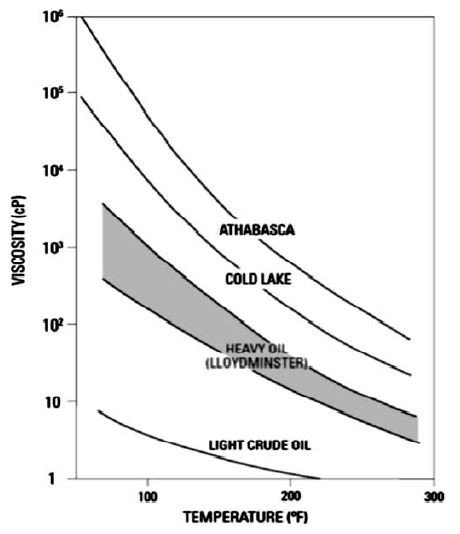
Figure 1. Crude Oil Viscosity as a Function of Temperature (Dong et al., 2019)
Any well's oil production goes through three stages. Under well pressure, oil is naturally extracted in the first stage; the second stage begins when the well pressure drops. In the second stage, sea or brackish water is pumped into the well, forcing oil upward. Twenty to thirty percent of the well reserve is removed after the well's primary and secondary oil production stages. More than 70 percent of the oil is still present in the well, despite claims to the contrary. The third stage, often known as enhanced oil recovery or tertiary recovery, begins at this point. It is predicted that just one-third of the available oil is produced globally. Therefore, as demand rises and there is a supply shortfall, we should be able to produce more oil by adopting EOR processes. This paper presents a brief review of Enhanced Oil Recovery (EOR) processes. It is anticipated that EOR technologies will be essential in supplying the world's energy needs in the years to come given the drop in oil finds over the past few decade.
After traditional recovery techniques are used up, approximately 2.0 1012 barrels (0.3 1012 m3 ) of conventional oil and 5.0 1012 barrels (0.8 1012 m3 ) of heavy oil may still be present in reservoirs around the world (Eriksson, 2007). Enhanced Oil Recovery (EOR) techniques, which are a component of the overall Improved Oil Recovery (IOR) strategy, would be used to recover a large portion of this oil. The traditional method (initial recovery), which extracts crude oil by using the reservoir's natural pressure, results in a large amount of Original Oil In Place (OOIP) remaining in some cases (more than 70%), due to a fall in reservoir pressure (Tunio et al., 2011). To enhance oil recovery, it is therefore essential to use secondary oil recovery, which entails fluid (mostly water and gas) injection to boost reservoir pressure, as well as EOR, also known as tertiary recovery (Mokheimer et al., 2019).
In Eriksson (2007) component-based modelling methodology for turbocharged engines is described and applied. Several component models are compiled and reviewed. In addition, new models are developed for compressor efficiency, compressor flow, and turbine flow. Finally, two application examples are given where the modelling methodology and component models have been used. The applications are, firstly, observer design and air/fuel ratio control of SI engines, and, secondly, control design of Direct Injection (DI) engines with Variable-Geometry Turbochargers (VGT) and Exhaust Gas Recirculation (EGR).
Tunio et al. (2011) work is a research and experimentation project based on advancements in enhanced oil recovery techniques, with the goal of reviewing current techniques and determining what advancements have been made in these techniques that result in better oil production. Experimenting (with two of these techniques: direct carbon dioxide injection and Water Alternating Gas (WAG) injection) and then comparing laboratory results for recovery via a series of laboratory experiments on core flooding, is done followed by a discussion of the obtained results.
Mokheimer et al. (2019) depict how the oil production from any well passes through three stages. The first stage is the natural extraction of oil under the well pressure; the second stage starts when the well pressure decreases. After the first and second stages of oil production from the well, 20–30% of the well reserve is extracted. The well is said to be depleted, while more than 70% of the oil is left over. The third stage starts, and it is called "Enhanced Oil Recovery" (EOR) or "tertiary recovery." Enhanced oil recovery is a technology deployed to recover most of our finite crude oil deposits. Thermal EOR is considered the dominant technique among all the different methods of EOR. This article presents a brief overview of EOR classification in terms of thermal and non-thermal methods.
Dong et al. (2019) present a comprehensive and critical review of the Enhanced Oil Recovery (EOR) processes in the post-steam injection era in both experimental and field cases. Specifically, the paper presents an overview of the recovery mechanisms and field performance of thermal EOR processes by reservoir lithology (sandstone and carbonate formations) and offshore versus onshore oilfields. Typical processes include an in-situ combustion process, a thermal-solvent process, a thermal (Non- Condensable Gas (NCG), e.g., N2, flue gas, and air) process, and a thermal-chemical (e.g., polymer, surfactant, gel, and foam) process.
Zou et al. (2016) predict the future situation of global energy development. In view of this, the history of energy use is understood that new energy sources will usher in a new era, following oil and gas, coal, and wood one after another as in the past. Although there are still plenty of fossil energy sources in the world, significant advances in some key technologies, as well as an increasing demand for ecological environmental protection, are driving the third phase of the transition from oil and gas to new energy sources.
While EOR procedures require altering the composition of the reservoir, in secondary recovery, water or gas is injected to help move the oil through the wells without changing the properties of the hydrocarbon itself. As shown in Figure 1, significant characteristics of the crude oil, such as density and viscosity, alter oil displacement in the reservoir, making its design simpler.

Figure 1. Crude Oil Viscosity as a Function of Temperature (Dong et al., 2019)
Depending on the EOR technology used, oil recovery can be as high as 60% of the Original Oil In Place (OOIP). A number of parameters, primarily technological and economic, have an impact on the recovery expected and the method of selection. While some of these have found commercial success, others are primarily of interest to academics. Only a few recovery techniques have been economically effective, including miscible carbon dioxide for light oil reservoirs and steam injection-based operations in heavy oils and tar sands (if the reservoir affords favorable conditions for such applications) (Mokheimer et al., 2019). Other recovery techniques have been tried, and some of them have even produced additional oil, but they all have drawbacks. The current EOR technologies are given in the correct context, highlighting the technical causes of their failure. Both in the lab and on the ground, there has been a lot of interest in methods for enhancing oil recovery, particularly those that focus on reducing interstitial oil saturation (Zou et al., 2016).
Numerous reservoirs that can be used to inject steam and carbon dioxide have already been used and are nearing maturity. Other EOR techniques include drawbacks that are not particularly related to the economy. Only a few technologies, under strict conditions, have been effective at recovering incremental oil, which is a difficult and expensive procedure. Nevertheless, given the rising demand for energy and the limited supply, EOR will continue to play a significant role in oil production. As shown in Figure 2, EOR is expected to alter the prediction for oil production in the Middle East and elsewhere. This data demonstrates that the EOR market worldwide is anticipated to grow dramatically in the future, underscoring its importance (Zou et al., 2016). The past seven years' contribution of the EOR market to the global economy is plotted for volume against revenue. Here the revenue and the volume increase with the year's pass-through, as shown in Figure 2(a). As shown in Figure 2(b), the Organization of the Petroleum Exporting Countries (OPEC) estimated that EOR would increase oil production in the Middle East by 2050 (Dong et al., 2019). These statistics encourage the Middle Eastern countries to enter the development phase.
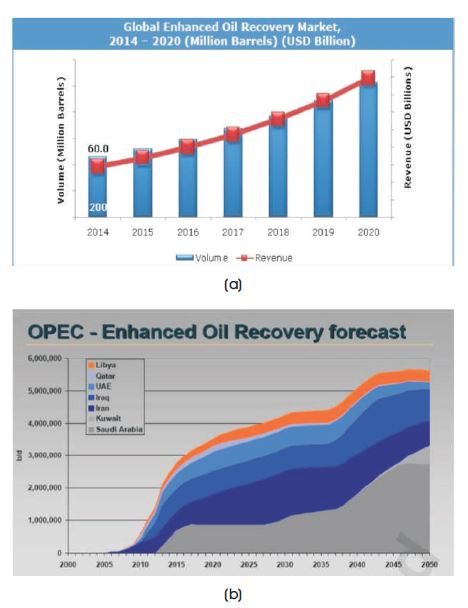
Figure 2. (a) Past Seven Years EOR Market Contribution to the Global Economy (Mokheimer et al., 2019), (b) Significant Increase in EOR in the Middle East (OPEC) by 2050 (Eriksson, 2007)
Sometimes people use the phrases EOR and IOR interchangeably. Improved Oil Recovery (IOR), is horizontal wells and infill drilling which enhance vertical and areal sweep, increasing oil recovery by any methods, for instance, operational tactics (Eriksson, 2007). The more precise idea of enhanced oil recovery, or EOR, can be thought of as a subset of improved oil recovery. EOR methods target to reduce the oil saturation below the residual oil saturation. Low oil saturation below residual oil saturation will allow recovery of oils due to high viscosity, which are immobile or almost immobile (heavy oils and tar sands) and oils that have been retained by capillary forces following a water flood in light oil reservoirs (Mokheimer et al., 2019).
EOR techniques that are successful at lowering residual oil saturation include miscible procedures, chemical floods, and steam-based solutions. IOR deals with the measurement, or increase of oil production from a well, in contrast to the output at a given point in time. EOR refers to advancements in technology and equipment that is separate from conventional extractions.
This paper's primary emphasis is on EOR techniques. One of the screening factors for EOR approaches is reservoir lithology, which frequently restricts the use of particular EOR methods. According to data compiled by the authors over the years from 1,507 international EOR operations, Figure 3 reveals that sandstone reservoirs have seen the majority of EOR applications. Figure 3 shows that, as compared to other lithologies, sandstone reservoirs typically use EOR thermal and chemical projects (e.g., carbonates and turbiditic formations (Alvarado & Manrique, 2010).
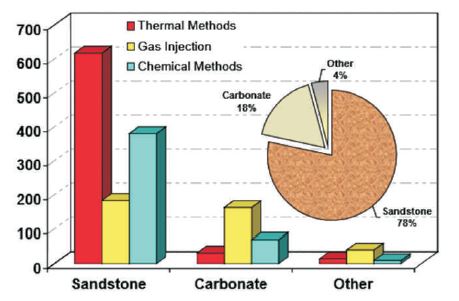
Figure 3. EOR Methods By Lithology (Based on a Total of 1,507 projects) (Medina et al., 2019)
It is well known that EOR methods have been extensively implemented in sandstone formations. In general, sandstone reservoirs show the highest potential to implement EOR projects because most of the technologies have been tested at pilot and commercial scale in this type of lithology. Additionally, there are some fields where different EOR technologies have been evaluated successfully at pilot scale demonstrating technical applicability of different EOR methods in the same field.
A variety of EOR procedures have been used in the past with varying degrees of success for the extraction of light and heavy oils as well as tar sands. Thermal recovery is the most prevalent type of EOR and works by heating the oil to reduce its viscosity and allow easier flow to the surface. Thermal procedures are generally made for heavy oils and tar sands, although they can occasionally be employed with light oils. Non-thermal methods are mainly used for light oils.
In the next few years, as fossil fuel demand grows and light crude oil depletes, heavy and unconventional crude oils will be needed to meet demand. Oil and gas companies have chosen to utilize new technologies to improve the efficiency of Enhanced Oil Recovery (EOR) processes to deal with this challenge (Medina et al., 2019). Offshore heavy oil is developed using a multi-thermal fluid process. In the development of the Bohai Oilfield, the company has achieved remarkable results. There is no question that the most successful method of enhancing oil recovery has been thermal recovery, specifically steam injection (Huang et al., 2018). By reducing viscosity, heat thins heavy oils, improving their predictability, and shifting rock wettability to favor oil recovery. In sandstone rocks, where temperature and saturation affect relative permeability, water injection temperature can also have a big influence on overall oil recovery (Mokheimer et al., 2019).
A number of enhanced oil recovery techniques take advantage of the thermal capabilities of steam to generate the breakdown of heavy molecules using gasification, methanation, steam reforming, hydrogenation, aqua thermolysis, and water-gas shift processes, as shown in Figure 4 (Dong et al., 2019). The industry is seeking ways to make these processes more efficient because steam injection techniques do not offer recovery percentages higher than 50%. By combining these techniques with nanotechnology, the main challenge has emerged with the aim of reducing asphaltene decomposition temperatures and improving oil recovery (Siavashi & Doranehgard, 2017).
Steam injection enhanced oil recovery is also called thermal recovery or steam flooding and refers to the injection of water vapor at high pressure and temperature into a well to mop up stranded oil from the reservoir following a decline in the formation pressure. To carry out steam injection, an operator drills one or more 'injection' wells close to the well for stimulation. Next, steam is introduced into the formation via the injection well(s).
When it contacts the oil, it lowers its viscosity and increases its kinetic energy, improving mobility toward the production casing. Steam injection is particularly useful for oil recovery in heavy oil reservoirs.
Many steps are depicted in Figure 4, including the formation of a viscoelastic asphaltene network, the adsorption of asphaltene onto nanoparticles, which reduces viscosity by disaggregating the viscoelastic network, and the generation of steam injection, catalytic steam gasification of asphaltene with nanoparticle assistance, and gasification of heavy hydrocarbons which typically produce the byproducts (Medina et al., 2019).
To successfully expand the use of nanoparticles in thermally enhanced oil recover y processes, a technology implementation plan that produces superior outcomes in pilot tests must be created. In order to optimize the process and reduce the risks and ambiguities associated with conventional technology, nanotechnology will be used while taking into account the key performance metrics and technological limitations (Kovscek, 2012).
An Anton Paar rheometer was used to measure the viscosity change trends of heavy oil at different temperatures, as shown in Figure 5. The viscosity of heavy oil decreases significantly as temperature rises. The viscosity of heavy oil decreases slightly when temperatures exceed 105 °C.

Figure 5. Graph of Heavy Oil's Viscosity-Temperature Relationship (Huang et al., 2018)
Furthermore, Figure 6 shows that the four components of the developed heavy oil did not change significantly at 120 °C and 200 °C. In summary, the primary mechanisms involved in heating heavy oil are viscosity reduction and thermal expansion. Hot water flooding reduces the viscosity of the crude oil, allowing it to move more easily toward production wells.
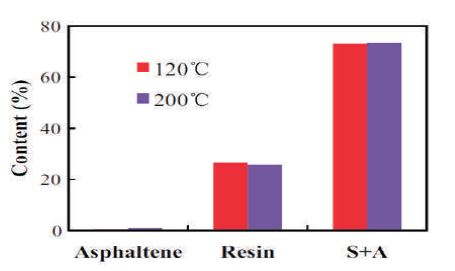
Figure 6. Distribution Diagram of the Four Components at Different Temperatures (Huang et al., 2018)
In comparison with steam injection, hot water flooding is less efficient because water has a lower thermal energy content. Water, however, has a higher driving power than steam. Injecting steam continuously into a porous oil bearing medium is the process of steam injection. In this way, the oil viscosity is greatly reduced, causing a zone of constant temperature and slow-moving steam, which results in increased oil mobility. Biopolymer and SiO2nanoparticles injected into one pore volume achieved the highest efficiency of 78%. The recovery rate of steam flooding is usually between 50% and 60% of OOIP (Hu et al., 2020).
A common feature of heavy oil steam flood and cyclic steam injection operations is the presence of emulsions. Emulsions of Oil In Water (O/W) and Water In Oil (W/O) can be formed. Steam condensation produces substantial mixing and agitation in the reservoir due to its large specific volume change. There is a possibility that an Anionic Water In Oil (AW/O) emulsion of heavy or viscous oils will have a higher viscosity than the original emulsion (Mokheimer et al., 2019). Anionic Water In Oil (AW/O) emulsions are commonly more viscous than the water phase, and their viscosity depends on the volume fraction of oil in them. Further, the amount of oil (Srinivasareddy & Kumar, 2015) and water (Pavan et al., 2022) expressed in terms of their saturation would also play a major role in the heavy oil recovery.
In the in situ combustion process, the crude oil in the reservoir is ignited and the fire is sustained by air injection. Water injected with air can capture and advance more heat stored in the burned zone, a technique where water is injected along with or, alternatively, with air into the reservoir. The injected water recovers the heat from the hot formation behind the combustion front and allows more efficient displacement of the oil.
Oil molecules are modified as a result of higher temperatures. As the temperature increases, heavy molecules tend to crack into smaller molecules. When superheated steam is present or during in-situ combustion, in-situ upgrading can be achieved. Components that are lighter and more volatile move through the reservoir more rapidly during in-situ combustion (Eriksson, 2007). In situ combustion is characterized by the variations namely combustion in forward motion, combustion in reverse and the injection of air at a high pressure.
As air flows in the opposite direction, forward combustion heats the injection well and ignites the injection zone (Kumar & Reddy, 2017; Srinivasareddy & Kumar, 2015), while reverse combustion heats the production well. There has not been any success with reverse combustion in the field. When high-pressure air is injected into the oil, it oxidizes at low temperatures. The ignition isn't turned on. The procedure is being tested in a number of heavy oil (Reddy & Kumar, 2014) and light oil reservoirs (Reddy & Kumar, 2015).
When secondary oil recovery is not enough, tertiary oil recovery begins. Almost all recovery processes reduce viscosity, including tertiary recovery. Oil reservoirs in Wyoming and California contain moderately viscous oils (50–200 cp), which are suitable for non-thermal oil recovery procedures instead of conventional steam- and fire-flooding techniques (Selby et al., 1989). Numerous non-thermal methods of heavy oil recovery have been tried in the past, but only with limited success. A variety of flood methods are employed, such as water flooding and pattern rotation. Heavy oil recovery may be successful using non-thermal methods under somewhat restrictive conditions (Ali, 1976). Heteroatoms such as nitrogen, sulphur, and oxygen play an important role in making the oil heavy since asphaltic molecules and substitutions in the carbon network are common. The heavy fractions of asphaltenes, heavy metals, sulphur, and nitrogen in heavy oil are always present, regardless of the source (Kovscek, 2012).
Oil extraction is increased by injecting carbon dioxide into a reservoir. An existing well, shown in Figure 7, can provide an understanding of this process. There have been few carbon dioxide floods before, the first took place in 1994 (Ali, 1976). By doing so, the reservoir's pressure will be restored to a level suitable for production.
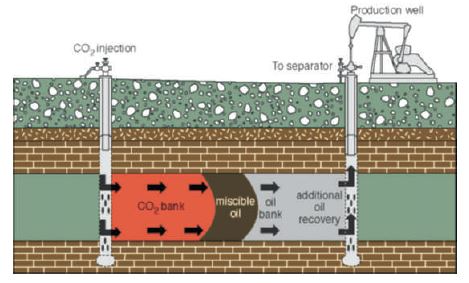
Figure 7. Carbon Dioxide Flooding (Alvarado & Manrique, 2010)
As a result, a production well is shut down and water is injected. As a result of the water, the sweep is increased, and flushing should be done efficiently and with the least amount of carbon dioxide possible. Following the pressure restoration, carbon dioxide will be injected into the same injection well. Oil can be miscible with carbon dioxide when it comes into contact with the gas (Ali, 1976).
Carbon Dioxide (CO2) flooding is a process whereby carbon dioxide is injected into oil reservoirs in order to increase output when extracting oil, especially in reservoirs where production rates have declined over time. This process of injecting CO2 into existing oil fields is a well-known Enhanced Oil Recovery (EOR) technique. In addition, CO2 increases the overall pressure of an oil reservoir, forcing the oil toward production wells. Deep, water-wet reservoirs were more effective for the process. We can inject immiscible CO2 in four different ways: continuously, by slugs, alternately or simultaneously, or by alternating CO2 with water slugs. Improved mobility control can be achieved by injecting CO2 and using water slugs over displacement alone, though oil entrapment may pose a disadvantage.
The process of creating miscible carbon dioxide involves the vaporization of crude oil, the growth of miscible CO2 , and the diminution of interfacial tension. When emphasis is placed on immiscible carbon dioxide displacement, the viscosity and swelling of the crude oil are the main determinants. In recent years, corrosion and foaming problems have been the most common problems encountered with carbon dioxide flooding. Carbonic acid is responsible for the corrosion problem.
It is well known that a considerable portion of the world's hydrocarbon endowment is in carbonate reservoirs. Carbonate reservoirs usually exhibit low porosity and may be fractured. These two characteristics, along with oil-tomixed wet rock properties, usually result in lowered hydrocarbon recovery rates. When EOR strategies are pursued, the injected fluids will likely flow through the fracture network and bypass the oil in the rock matrix. The high permeability of the fracture network and the low equivalent porous volume frequently result in early breakthrough of the injected fluids.
A large number of EOR field projects in carbonate reservoirs have been referenced in the literature during the last two decades. Although these field projects demonstrate the technical feasibility of various EOR methods in carbonate reservoirs, gas injection, whether continuous or in a Water Alternating Gas (WAG) mode, is still the most common EOR process implemented in this type of lithology. Polymer flooding is the only proven EOR chemical method in carbonate formations, while EOR thermal methods have made a relatively small contribution to the world's oil production from carbonate reservoirs. However, High Pressure Air Injection (HPAI) projects have been steadily increasing in recent years, especially in light oil carbonate reservoirs. EOR technologies have been evaluated successfully at the pilot scale, demonstrating the technical applicability of different EOR methods in carbonate formations.
This study contains an in-depth discussion of EOR in the oil industry. EOR of heavy oil reservoirs still relies heavily on thermal methods, specifically steam injection. Only a few of the numerous EOR techniques studied have achieved commercial success. Recent years have seen CO 2 injection gain popularity as an EOR method and as a potential sequestration method. With 67% global utilization, thermal EOR is the most common EOR technique. In steam flooding, viscosity is reduced by thermal energy and steam is distilled. Additionally, the extraction effect and the aqua thermal cracking reaction improved oil displacement. For heavy oils and tar sands, steam injection-based recovery techniques like Cyclic Steam Stimulation (CSS) and steam flooding have had great success. Processes that recover heavy oil face the most urgent issues of steam breakthrough, low sweep efficiency, and low steam efficiency. One of the significant EOR techniques is in-situ combustion. It can function at up to 22 bar starting reservoir pressure. Light oils have shown significant success with miscible CO2 flooding. However, the economics are still unclear. Despite the growing research interest in chemically assisted methods to improve oil recoveries in carbonate formations, these projects are not expected to impact global oil production in the near future. The ultimate goal is to reduce the cost of heating while minimizing the environmental impact of the EOR approach that is being deployed.